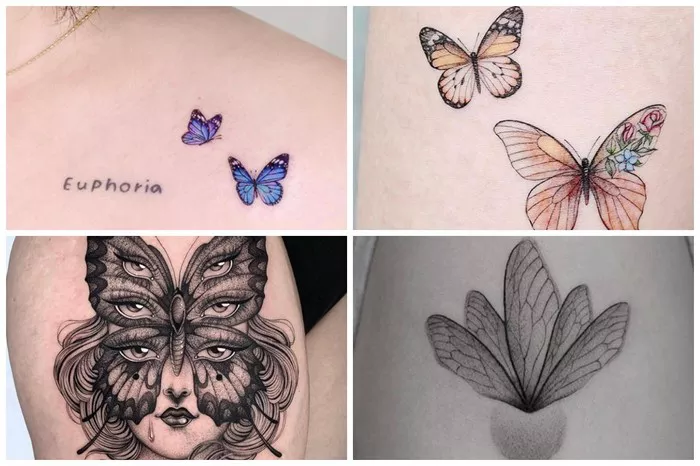Butterfly tattoos have long been a staple in the world of body art, admired for their delicate beauty and rich symbolism. These tattoos adorn the bodies of people from diverse backgrounds, each imbued with unique meanings and stories. From symbolizing transformation and freedom to reflecting cultural beliefs, the butterfly tattoo continues to captivate both wearers and observers alike. In this article, we delve into the multifaceted world of butterfly tattoos, examining their symbolism, cultural perceptions, personal narratives, expert opinions, and current trends.
Symbolism of Butterfly Tattoos
One of the most prevalent interpretations of butterfly tattoos is that of transformation. Much like the butterfly undergoes a metamorphosis from a humble caterpillar to a magnificent winged creature, individuals may choose this design to symbolize their own personal growth and evolution. The image of a butterfly emerging from a cocoon can serve as a powerful reminder of resilience and the potential for positive change.
Furthermore, butterfly tattoos are often associated with freedom and liberation. The graceful fluttering of butterfly wings evokes a sense of lightness and unrestrained movement, symbolizing the desire to break free from societal constraints or personal struggles. For some, the tattoo may represent a newfound sense of autonomy and self-expression.
Additionally, butterfly tattoos are admired for their innate beauty and elegance. The intricate patterns and vibrant colors of butterfly wings make for visually stunning designs, appealing to those who appreciate aesthetic artistry. Whether rendered in bold realism or stylized abstraction, butterfly tattoos are celebrated for their aesthetic appeal and timeless allure.
Cultural Perceptions
Across different cultures, butterfly tattoos hold varying significance and symbolism. In many Western societies, they are commonly associated with notions of femininity, grace, and whimsy. For women, in particular, butterfly tattoos may symbolize empowerment and self-discovery, serving as a declaration of independence and inner strength.
Conversely, in some Eastern cultures, butterflies carry deeper spiritual meanings. In Japanese folklore, for example, butterflies are often seen as symbols of the soul and are believed to represent the ephemeral nature of life. In Chinese culture, the butterfly is associated with love, longevity, and joy, making it a popular motif in traditional art and literature.
In Indigenous cultures, butterflies may hold sacred significance, representing the interconnectedness of all living beings and the cyclical nature of existence. Among Native American tribes, the butterfly is sometimes viewed as a messenger of transformation and spiritual rebirth, carrying prayers to the heavens.
Personal Stories
Behind every butterfly tattoo lies a unique narrative, shaped by the individual experiences and motivations of the wearer. For some, the tattoo may serve as a commemoration of significant life events, such as overcoming adversity or embracing newfound freedom. Others may choose the design as a tribute to a loved one or as a symbol of hope and renewal in the face of hardship.
“I got my butterfly tattoo after surviving a challenging period of my life,” says Sarah, a 28-year-old graphic designer. “It symbolizes my journey of self-discovery and the freedom I’ve found in embracing my true identity.”
Similarly, Jake, a 35-year-old army veteran, shares his reason for getting a butterfly tattoo: “After returning from deployment, I struggled with PTSD and feelings of isolation. The butterfly represents my journey towards healing and reclaiming my sense of agency.”
Expert Opinions
Tattoo artists and cultural experts offer valuable insights into the significance of butterfly tattoos and their enduring appeal. According to renowned tattoo artist Mia Johnson, butterfly tattoos continue to be popular among clients of all ages and backgrounds.
“I’ve noticed a significant increase in requests for butterfly tattoos in recent years,” says Johnson. “Clients are drawn to the symbolism of transformation and the timeless beauty of butterfly designs. It’s a tattoo that holds deep personal meaning for many people.”
Cultural anthropologist Dr. Raj Patel emphasizes the cross-cultural significance of butterfly tattoos, highlighting their universal appeal and diverse interpretations.
“Butterfly tattoos transcend cultural boundaries and hold different meanings across various societies,” explains Dr. Patel. “Whether viewed as symbols of transformation, freedom, or spiritual enlightenment, they serve as potent reminders of the human experience and our collective desire for growth and renewal.”
Trends and Popularity
In the realm of body art, butterfly tattoos remain a perennial favorite, continuously evolving to reflect changing tastes and aesthetic preferences. While traditional designs featuring realistic depictions of butterflies remain popular, contemporary variations often incorporate abstract elements and geometric patterns.
Moreover, the placement of butterfly tattoos has become increasingly diverse, with individuals opting for creative locations such as the collarbone, wrist, or ankle. This trend reflects a growing desire for unique and personalized tattoo designs that showcase individuality and style.
In recent years, minimalist butterfly tattoos have surged in popularity, characterized by simple linework and subtle shading. These understated designs offer a modern twist on a classic motif, appealing to those seeking a more discreet yet meaningful tattoo option.
In conclusion, butterfly tattoos continue to captivate enthusiasts around the globe, serving as timeless symbols of transformation, freedom, and beauty. From their rich cultural significance to deeply personal narratives, butterfly tattoos embody the myriad complexities of the human experience. As trends evolve and artistic expressions flourish, the allure of butterfly tattoos endures as a timeless emblem of self-expression and spiritual growth.

